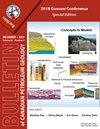白垩系油砂油侵位对成岩作用的影响
Q3 Earth and Planetary Sciences
引用次数: 2
摘要
摘要/ Abstract摘要:来自阿根廷Neuquen盆地、巴西Sergipe-Alagoas盆地、加拿大西部沉积盆地、中国准噶尔盆地、德国下萨克森州盆地、格陵兰岛Kangerlussuaq盆地、科威特阿拉伯盆地、尼日利亚乍得盆地、尼日利亚达荷美盆地、英国Moray Firth盆地的17块白垩系油砂薄片。利用扫描电子显微镜(SEM)对英国Wessex盆地和美国Utah盆地进行了研究,以加深我们对石油侵位如何影响成岩作用进程的理解。研究结果表明,在原油侵位之前,影响砂岩的成岩作用包括埋藏/压实作用、二氧化硅/方解石胶结作用、方解石取代碎屑颗粒/胶结作用以及二氧化硅过度生长的发育。大多数成岩作用在油侵入砂岩孔隙后停止,然而,观察到碎屑颗粒/胶结物的蚀变和自生矿物/金属化合物的沉淀等成岩作用在油侵入砂岩孔隙后发生。在研究的白垩纪油砂中,有些油是在砂岩未压实或胶结的较早阶段形成的。这些白垩纪油砂在石油侵位之前的孔隙度异常高,超过38%。在这些油砂中观察到的唯一水泥是与其相关的粘性重油(沥青)。在开采这些重油时,油砂坍塌成未固结的砂。这些沥青支撑的白垩纪砂岩的出现,意味着白垩纪砂岩在不同的盆地中沉积时,有运移石油的存在。部分白垩系油砂在经历了一定的成岩作用后,其孔隙空间并未完全被破坏,从而发生了油侵。这些白垩纪油砂在石油侵位之前具有10%-30%的中等至高孔隙度,其中一些砂岩显示出二氧化硅过度生长的证据。石油进入这些砂岩的孔隙被认为阻止了二氧化硅过度生长的进一步发展,而二氧化硅过度生长会导致这些白垩纪储层砂的孔隙度完全丧失。在研究的一些白垩纪油砂中,当砂岩经历了很长时间的成岩事件,导致孔隙度几乎完全丧失时,油侵就发生了。在白垩系油砂中观察到的常见成岩特征包括石英颗粒-颗粒接触和石英过度生长。本文章由计算机程序翻译,如有差异,请以英文原文为准。
Impact of oil emplacement on diagenesis in Cretaceous oil sands
Abstract Seventeen thin sections of Cretaceous oil sands from the Neuquen Basin (Argentina), Sergipe-Alagoas Basin (Brazil), Western Canadian Sedimentary Basin (Canada), Junggar Basin (China), Lower Saxony Basin (Germany), Kangerlussuaq Basin (Greenland), Arabian Basin (Kuwait), Chad Basin (Nigeria), Dahomey Basin (Nigeria), Western Moray Firth Basin (UK), Wessex Basin (UK) and Utah (USA) were examined using the scanning electron microscope (SEM) to improve our understanding on how oil emplacement impairs the progress of diagenesis. Our results show that diagenetic processes affecting sandstones prior to oil emplacement include burial/compaction, silica/calcite cementation, calcite replacement of detrital grains/cements as well as the development of silica overgrowth. Most diagenetic processes were inferred to cease upon oil emplacement into the pores of the sandstones, however, diagenetic processes such as the alteration of detrital grains/cements and precipitation of authigenic minerals/metallic compounds were observed to occur after oil emplacement into the pores of the sandstones. Oil was emplaced in some of the studied Cretaceous oil sands at a relatively early stage when the sandstones were not compacted or cemented. Such Cretaceous oil sands were observed to have had anomalously high porosities of above 38% prior to oil emplacement. The only cement observed in these oil sands are the viscous heavy oils (bitumens) associated with them. Upon extraction of these heavy oils, the oil sands collapse into unconsolidated sands. Occurrence of these bitumen supported Cretaceous sands implies availability of migrating oils while some of the Cretaceous sands were depositing in various basins. Oil emplacement occurred in some of the studied Cretaceous oil sands after the sandstones had undergone some diagenetic processes which did not destroy all their pore spaces. Such Cretaceous oil sands were observed to have had moderate to high porosities of 10%–30% prior to oil emplacement, with some of these sandstones showing evidence of silica overgrowth. Emplacement of oil into the pores of such sandstones is believed to have stopped further development of the silica overgrowth that would have led to the total loss of porosity in these Cretaceous reservoir sands. In some of the studied Cretaceous oil sands, oil emplacement occurred when the sands had experienced a long history of diagenetic events leading to almost total loss of porosity. Common diagenetic features observed in such Cretaceous oil sands include sutured quartz grain-grain contacts and quartz overgrowth.
求助全文
通过发布文献求助,成功后即可免费获取论文全文。
去求助
来源期刊

Bullentin of Canadian Petroleum Geology
Earth and Planetary Sciences-Geochemistry and Petrology
CiteScore
2.50
自引率
0.00%
发文量
0
期刊介绍:
The Bulletin of Canadian Petroleum Geology is a peer-reviewed scientific journal published four times a year. Founded in 1953, the BCPG aims to be the journal of record for papers dealing with all aspects of petroleum geology, broadly conceived, with a particularly (though not exclusively) Canadian focus. International submissions are encouraged, especially where a connection can be made to Canadian examples.
 求助内容:
求助内容: 应助结果提醒方式:
应助结果提醒方式:


